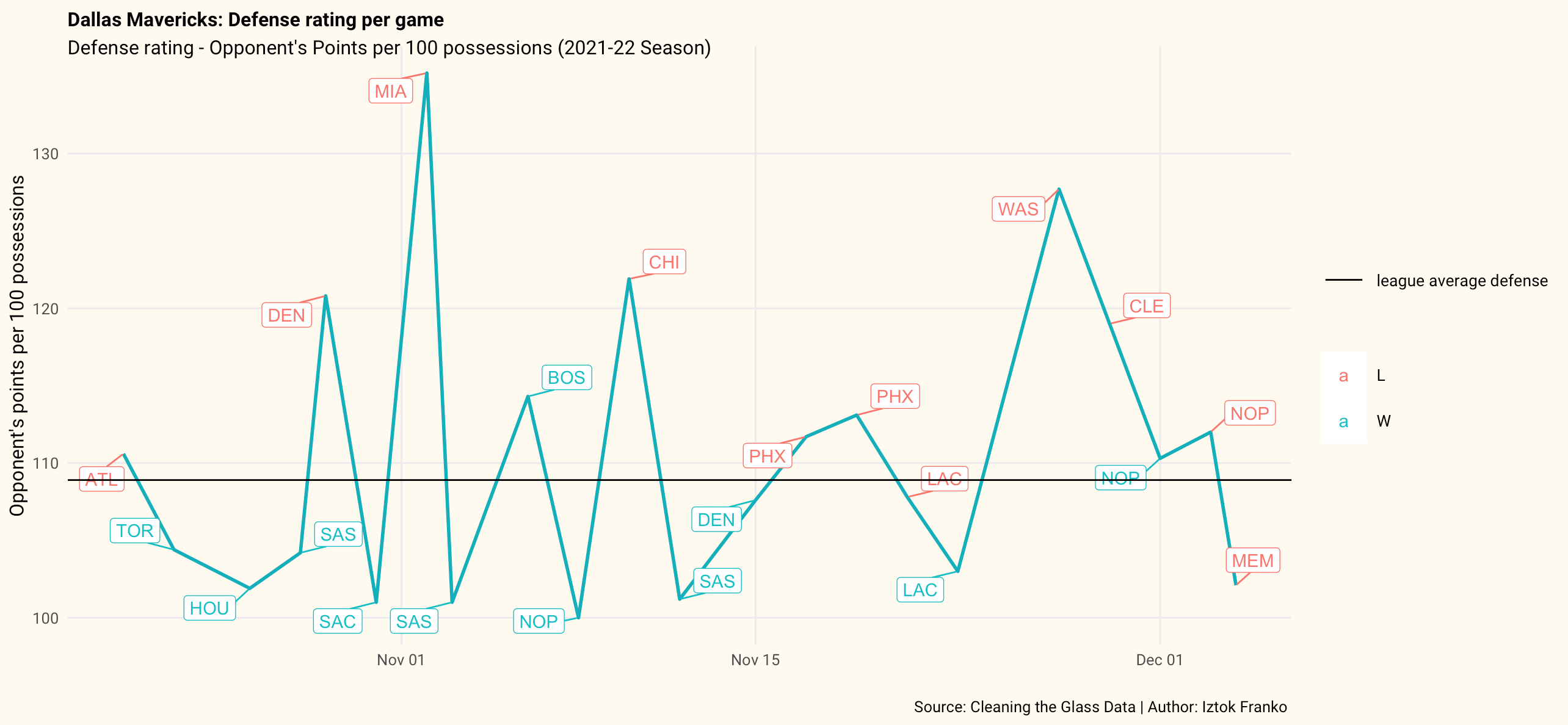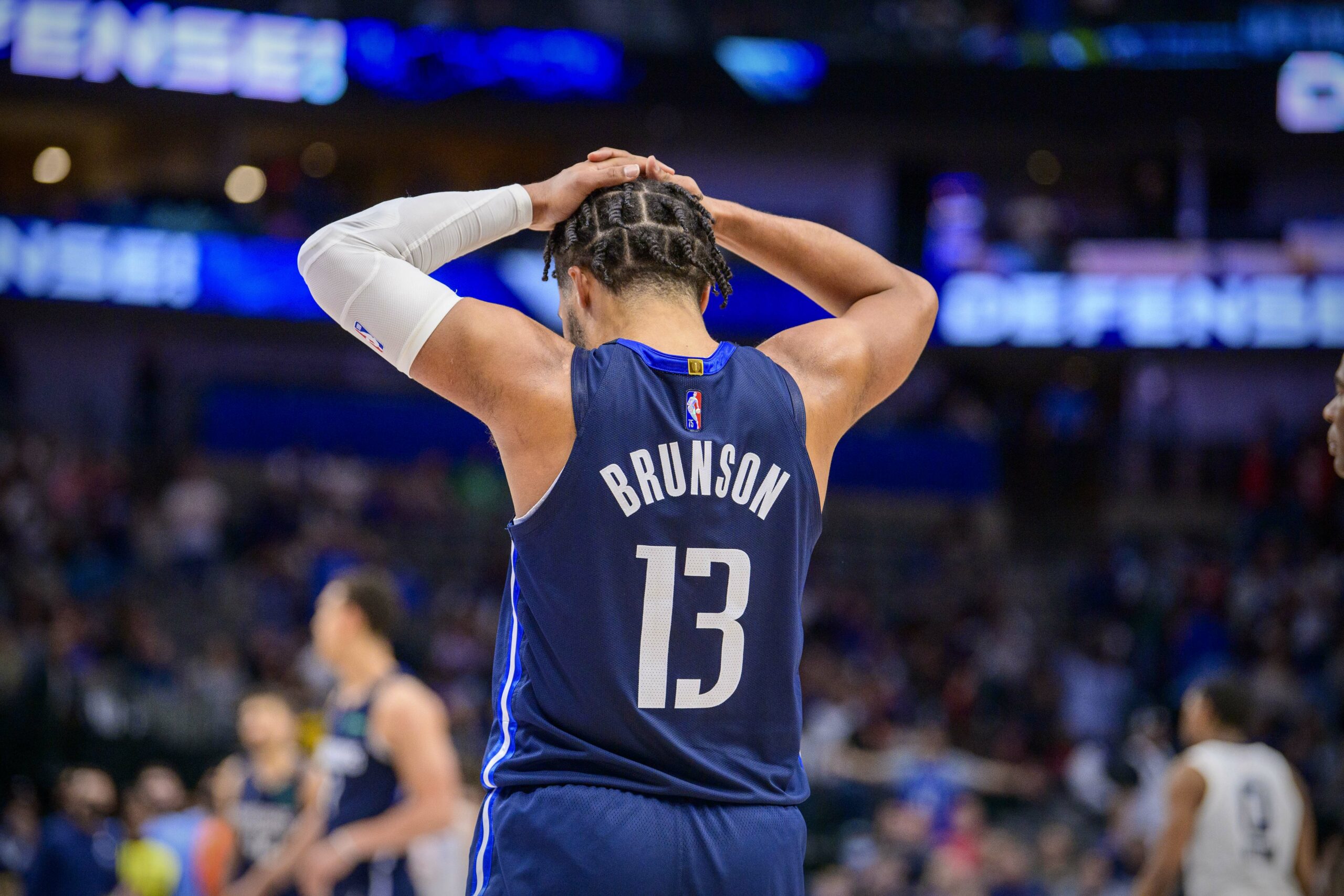No matter how hard Jason Kidd tries to sound upbeat in his post-game interviews, you can feel he is hurting inside. The man loves defense. Kidd has four NBA all-defensive first team and five all-defensive second team selections on his résumé. Kidd’s 2015-16 Milwaukee Bucks were one of the most aggressive defensive teams in the past decade. The Lakers, for whom Kidd worked as an assistant the last couple of seasons, were a defensive juggernaut. So it came as no surprise that when Kidd took over as head coach of the Mavericks, he made a bunch of noise about getting things together on defense. So much so that a big part of this team’s search for an identity is predicated on playing good defense.
Yet a quarter of the way into the season, the Dallas Mavericks are in a familiar spot: mediocre defensively. They headed into last week as the NBA’s 22nd-ranked defense — exactly where they finished last season — before a low-scoring loss to the Memphis Grizzlies pushed them up to 19th.
I’m not here to dispute the logic of making defense a priority. This team is really good on offense — or was, but that’s a story for another day — so you can talk yourself into thinking they can at least get to the second round of the playoffs if they’re just average on the other side of the ball. Last season the Mavericks lost only four games — including the seven-game playoff series against the Clippers — when they played at least league-average defense. So far this season, they’ve won all but two games when the same happened, neither of which Luka Doncic played in.
The problem is that the Mavericks don’t show up on defense often enough. And when they don’t, things quickly go from bad to worse. At least five losses this season have featured defensive collapses of epic proportions.

The confusing part is that the Mavericks genuinely look like they are trying harder. Kidd and his defensive coordinator, Sean Sweeney, implemented a new scheme that requires much more activity than Rick Carlisle’s more conservative schemes.
What does that look like? Let me get technical for a minute.
In the new scheme, big men need to show higher in pick-and-roll, closer to the level of the screen. The Mavericks are trying to blitz and show two defenders on the ball more often to prevent drives to the rim, which means the backline needs to defend a 4-on-3 situation if the ball gets by the front line of the defense. The Mavericks are also more aggressive with their ICE coverages. If you listen carefully during the Mavericks’ broadcast, you’ll hear the word “ice” screamed more often than any other from the sidelines — well, maybe a close second to Doncic’s Serbian swear words. “Icing” a side pick-and-roll is a commonly used concept that prevents ball-handlers from driving to the middle, but it requires the backline to rotate and tag the roll man because two primary pick-and-roll defenders are containing the ball.
Even more important, Kidd and Sweeney implemented a more aggressive help defense. The goal of the new help principles is to “shrink” the floor as much as possible to protect the paint and elbows. Shrinking the floor means off-ball defenders collapse in a help position and then rotate with hard close-outs to the three-point line once the ball is reversed. To emphasize the importance of help defense, Kidd used a trick he learned from Frank Vogel in Los Angeles and put special lines on the floor of Maverick’s practice court to demonstrate where he wants help defense to take place.
“We’re helping [more]. We’re showing help more than we did last year,” said Trey Burke in training camp by way of explaining the difference in help scheme. “If I’m on offense and I’m coming down, I see that weak-side shifted. It’s emphasizing us shifting and showing that we’re going to be there on the help side. If a guy does get beat on the ball, somebody is there to help.”
The Mavericks do X-out rotations — “X” stands for X-shaped pattern — which means the player who is closest to the player receiving the kick-out pass will do the close-out and trust their teammate to take their original matchup. In a recent blowout win against the New Orleans Pelicans, you could see all elements of the new scheme in action whenever Brandon Ingram tried to attack. I made this video to show you exactly what I mean:
You can see the new system requires more decision-making and all five players to be in sync. Fast rotations and aggressive close-outs need to happen out of “shrink” and help situations. Which is fine. The concept of Sweeney’s scheme is sound.
And, in certain ways, so is the execution. The Mavericks force opposing teams into tough shots, ranking first in frequency of an opponent’s long mid-range attempts (the least efficient areas on the floor) and, per Second Spectrum, second in opponent’s shot quality. That’s generating bottom-line results against weak opposition. The Mavericks rank 15th in defense against the NBA’s 10 worst teams.
The Mavericks run into problems when they face a good team that can keep them moving and scrambling. It’s especially bad against really good teams. Dallas ranks 28th defensively against the league’s 10 best teams.
Here’s where personnel comes into play. When you watch the Mavericks play defense, it’s evident they lack long, athletic defenders who would flourish in this new, more aggressive defensive scheme. Dorian Finney-Smith is the only such player in the starting lineup, and he usually draws the toughest on-ball assignment. Consequently, he is rarely used as a help defender. The players used as help defenders often struggle when they have to keep moving and make more than two rotations, something Finney-Smith highlighted as the biggest problem the defense currently faces. Those third and fourth rotations require change-of-direction skills, fast lateral movement, and good defensive instincts — and Doncic, Kristaps Porzingis, Tim Hardaway Jr., and Jalen Brunson each lack at least one of those things.
Kidd began the season with his most agile and athletic defenders — Maxi Kleber, Frank Ntilikina, Willie Cauley-Stein, and Reggie Bullock — on the bench, and this is where we bump into the second problem: the dreaded, much-debated two-big lineups. I get why Kidd insists on starting lineups that feature Porzingis next to another center; the Mavericks must minimize the wear and tear on the Latvian’s body during the regular season to keep him healthy for the playoffs.
But the numbers have been so brutal over the last two seasons that the Mavericks might not get there in the first place if they continue playing the way they have been. Per Cleaning the Glass, lineups with Porzingis at the power forward position allow 109.4 points per 100 possessions, which is in the lower half of all NBA lineups. There are some real extremes baked into this data. When Porzingis is at the four, the Mavericks rank as the best — literally, the 100th percentile — among all lineups in defensive rebounding and in foul rate. They are also literally the worst — bottom 1 percent — in opponent’s effective field goal percentage. In simpler terms, they don’t foul and they rebound well, but opponents hit absurd amounts of shots, mostly at the rim (71 percent shooting) and three-point range (43 percent).
When Porzingis plays at the four, he has to rotate more, do more close-outs to the three-point line, and defend in space. Any situation when Porzingis gets away from the paint is a bad situation for the Dallas Mavericks because the task of protecting the paint is often left to Dwight Powell, a scenario most Mavericks fans want to erase from their memories.
I’m not singling out Porzingis here; the vast majority of his 406 possessions at the power forward spot were in a lineup with Doncic, Hardaway Jr., Powell, and Finney-Smith. But it’s wasteful considering how excellent he is at protecting the paint as a center and, in turn, how much better the defense is as a whole when he does it. Dallas allows almost two points fewer — 107.5 points per 100 possessions, or 59th percentile in the NBA — when that happens. When you pair Porzingis with Maxi Kleber in the frontcourt, the Mavericks reach the upper echelon NBA defense: 100.9 points per 100 possessions — 96th percentile — and are elite at protecting the rim.
This is not a new trend; those lineups were very good on defense last season as well, even in a year when Porzingis struggled and looked less mobile than he does now. Mavericks fans probably want to forget the Josh Richardson experience, but the lineup of Doncic, Richardson, Finney-Smith, Kleber, and Porzingis that started the majority of last season outscored opponents by 11.2 points per 100 possessions. The takeaway? If the Mavericks want to make the Doncic-Porzingis pairing work, they have to surround them with three mobile and athletic defenders, especially in the new defensive scheme.
This is where past roster construction failures hurt. In an area of skill-ball, Dallas has five centers — four of whom are non-shooting, one-dimensional big men — and one power forward on the roster. That limits the possible in-house solutions. (For the record, the Mavericks’ best defensive unit is probably with Kleber at the power forward spot and Bullock in Hardaway Jr.’s place to upgrade the on-ball pressure.) After 19 games of poor perimeter defense, Kidd made the first move to get there and moved Hardaway Jr. to the bench. But starting Kleber is more tricky. He is the glue guy who makes the Porzingis lineups work (fun fact: Kleber actually means glue in German), but he will turn 30 soon, is fragile, and has already missed nine games this season because of an injury. Dallas probably overused Kleber last season when he played a career-high 27 minutes per game because they depend on him way too much. How much can they really lean on him now?
Earlier in the season, general manager Nico Harrison said we’ll know what this team is after 20 games. Well, here we are, and we know what they aren’t: a good defensive team. Even Kidd conceded as much after a demoralizing loss in a rematch against the Pelicans, saying, “We’re built to play offense. We’re not built to play defense.”
They’ll have to add more defensive talent to shape this roster to fit the style Kidd prefers. Most of the Mavericks’ defensive failures start on the ball, so they’ll need a point-of-attack defender who can disrupt plays before they happen. An athletic wing defender or a mobile four who can play next to Porzingis is another hole to fill. But regardless of position, the Mavericks need someone who can make a difference. A disruptor. Kleber and Finney-Smith are OK, but nobody is mistaking them for Ben Simmons, Mikal Bridges, or even Alex Caruso. Unfortunately, Porzingis is not on the level of other anchor big defenders like Rudy Gobert, Bam Adebayo, or Clint Capela as well. There’s a reason no Maverick was among the 39 players who received All-Defensive Team selection votes last season.
We’re getting closer to the first trade deadline for Harrison and the new regime, and the moves they make — or don’t — will tell us how committed they are to shaping the team in Kidd’s image. As much criticism as the Mavericks’ first-year head coach has faced, it’s on the rookie GM to play some “help defense” of his own to find reinforcements.






